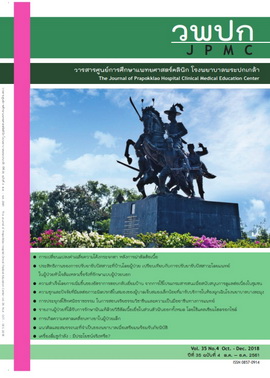Full Pulpotomy with Calcium Hydroxide in Permanent Teeth : Case reports
Main Article Content
Abstract
Full pulpotomy in permanent teeth aims for remaining the vital pulp in the root canals and relieving pain from acute pulpitis which is an alternative treatment for vital pulp therapy. These case reports demonstrate 3 patients who were 56, 57 and 13 years old, respectively. They were diagnosed with the proper condition and were received the treatment by using calcium hydroxide, according to the treatment protocols. At 27 to 79 months follow-up, the treatment outcomes were succeeded, none of the patients experienced spontaneous pain, and the radiographic evaluation revealed normal periapical areas. Consequently, vital pulp therapy with full pulpotomy by using calcium hydroxide is an effective and appropriate treatment for the patients.
Article Details
Section
Case Report
References
เอกสารอ้างอิง
1. American Association of Endodontists Guide to clinical endodontics. 4th ed. Chicago: AAE;
2004.
2. Boucher Y, Matossian L, Rilliard F, Machtou P. Radiographic evaluation of the prevalence
and technical quality of root canal treatment in a French subpopulation. IntEndod J
2002; Mar 1;35:229-38.
3. Khajornprai N. Endodontic re-treatment of taurodontic mandibular right second premolar: acase report. J PrapokklaoHospClin Med Educat Center 2017;34:54-62.
4. Ou KL, Chang CC, Chang WJ, Lin CT, Chang KJ, Huang HM. Effect of damping properties on
fracture resistance of root filled premolar teeth: a dynamic finite element analysis.Int
EndodJ 2009;42:694-704.
5. Randow K, Glantz PO. On cantilever loading of vital and non-vital teeth an experimental clinical study. ActaOdontolScand 1986;44:271-7.
6. Aguilar P, Linsuwanont P. Vital pulp therapy in vital permanent teeth with cariously exposed pulp: a systematic review. J Endod 2011;37:581-7.
7. Qudeimat MA, Alyahya A, Hasan AA. Mineral trioxide aggregate pulpotomy for permanent
molars with clinical signs indicative of irreversible pulpitis: apreliminary study. IntEndod
J 2017;50:126-34.
8. Linsuwanont P, Wimonsutthikul K, Pothimoke U, Santiwong B. Treatment outcomes of
mineral trioxide aggregate pulpotomy in vital permanent teeth with carious pulp
exposure: the retrospective study. J Endod 2017;43:225-30.
9. Caviedes-Bucheli J, Muñoz HR, Azuero-Holguín MM, Ulate E. Neuropeptides in dental
pulp: the silent protagonists. J Endod 2008 31;34:773-88.
10. Silva AF, Tarquinio SB, Demarco FF, Piva E, Rivero ER. The influence of haemostatic
agents on healing of healthy human dental pulp tissue capped with calcium
hydroxide. Intendod J 2006;39:309-16.
11. Jang Y, Kim H, Roh BD, Kim E. Biologic response of local hemostatic agents used in
endodontic microsurgery. Restor Dent Endod 2014; 39: 79-88
12. Rao A, Rao A, Shenoy R. Mineral trioxide aggregate—a review. J Clin Pediatr Dent
2009;34:1-8.
13. El-Meligy OA, Avery DR. Comparison of mineral trioxide aggregate and calcium hydroxide
as pulpotomy agents in young permanent teeth (apexogenesis). Pediatr dent 2006; 28:
399-404.
14. Cvek M. A clinical report on partial pulpotomy and capping with calcium hydroxide in permanent incisors with complicated crown fracture. J Endod 1978;4:232-7.
15. Chueh LH, Huang GT. Immature teeth with periradicular periodontitis or abscess
undergoing apexogenesis: a paradigm shift. J Endod 2006; 32:1205-13.
1. American Association of Endodontists Guide to clinical endodontics. 4th ed. Chicago: AAE;
2004.
2. Boucher Y, Matossian L, Rilliard F, Machtou P. Radiographic evaluation of the prevalence
and technical quality of root canal treatment in a French subpopulation. IntEndod J
2002; Mar 1;35:229-38.
3. Khajornprai N. Endodontic re-treatment of taurodontic mandibular right second premolar: acase report. J PrapokklaoHospClin Med Educat Center 2017;34:54-62.
4. Ou KL, Chang CC, Chang WJ, Lin CT, Chang KJ, Huang HM. Effect of damping properties on
fracture resistance of root filled premolar teeth: a dynamic finite element analysis.Int
EndodJ 2009;42:694-704.
5. Randow K, Glantz PO. On cantilever loading of vital and non-vital teeth an experimental clinical study. ActaOdontolScand 1986;44:271-7.
6. Aguilar P, Linsuwanont P. Vital pulp therapy in vital permanent teeth with cariously exposed pulp: a systematic review. J Endod 2011;37:581-7.
7. Qudeimat MA, Alyahya A, Hasan AA. Mineral trioxide aggregate pulpotomy for permanent
molars with clinical signs indicative of irreversible pulpitis: apreliminary study. IntEndod
J 2017;50:126-34.
8. Linsuwanont P, Wimonsutthikul K, Pothimoke U, Santiwong B. Treatment outcomes of
mineral trioxide aggregate pulpotomy in vital permanent teeth with carious pulp
exposure: the retrospective study. J Endod 2017;43:225-30.
9. Caviedes-Bucheli J, Muñoz HR, Azuero-Holguín MM, Ulate E. Neuropeptides in dental
pulp: the silent protagonists. J Endod 2008 31;34:773-88.
10. Silva AF, Tarquinio SB, Demarco FF, Piva E, Rivero ER. The influence of haemostatic
agents on healing of healthy human dental pulp tissue capped with calcium
hydroxide. Intendod J 2006;39:309-16.
11. Jang Y, Kim H, Roh BD, Kim E. Biologic response of local hemostatic agents used in
endodontic microsurgery. Restor Dent Endod 2014; 39: 79-88
12. Rao A, Rao A, Shenoy R. Mineral trioxide aggregate—a review. J Clin Pediatr Dent
2009;34:1-8.
13. El-Meligy OA, Avery DR. Comparison of mineral trioxide aggregate and calcium hydroxide
as pulpotomy agents in young permanent teeth (apexogenesis). Pediatr dent 2006; 28:
399-404.
14. Cvek M. A clinical report on partial pulpotomy and capping with calcium hydroxide in permanent incisors with complicated crown fracture. J Endod 1978;4:232-7.
15. Chueh LH, Huang GT. Immature teeth with periradicular periodontitis or abscess
undergoing apexogenesis: a paradigm shift. J Endod 2006; 32:1205-13.

